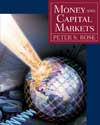 |  Money and Capital Markets: Financial Institutions and Instruments in a Global Marketplace, 8/e Peter Rose,
Texas A & M University
The Roles and Services of the Federal Reserve and Other Central Banks Around the World
Chapter SummaryIn this chapter, we have examined the important roles played by central banks in the global
financial system and the economy.
- Central banks must function to control the money and credit supply, maintain stable
conditions in the financial markets, serve as a lender of last resort to aid financial institutions
in trouble, and maintain and improve the mechanism for making payments for
goods and services.
- In most industrialized countries, central banking is goal-oriented, aimed principally at
the major economic goals of full employment, reasonable stability in the prices of goods
and services, sustainable economic growth, and a stable balance-of-payments position
with the rest of the world. In the Western world, central banks operate to achieve the
foregoing goals principally by working in the private financial marketplace, influencing
credit conditions but leaving to private borrowers and lenders the basic decision of
whether to create credit, borrow, and spend.
- Central banks appear to influence the spending, saving, and borrowing decisions of millions
of individuals and businesses through at least five interrelated channels—the cost
and availability of credit, the volume and rate of growth of the money supply, the market
value of assets held by the public, the relative prices of world currencies, and the
public’s expectations regarding domestic and international economic conditions.
- The central bank of the United States is the Federal Reserve System, whose chief administrative
body is the Board of Governors which controls such important policy tools as deposit
reserve requirements, margin requirements on purchasing stocks and other securities,
and changes in the discount rate on loans made by the Fed to depository institutions.
- Another important policy-making unit within the Federal Reserve System is the Federal
Open Market Committee (FOMC), composed of the seven members of the Federal Reserve
Board and the presidents of the 12 Federal Reserve Banks, which oversees the use
of the Fed’s chief monetary policy tool—open market operations.
- The 12 Federal Reserve banks represent the Fed’s regional presence across the United
States. These banks supervise private banks and financial holding companies within
their individual districts, decide which depository institutions can borrow reserves from
the Fed, and provide such services as clearing and collecting checks, shipping currency
and coin, wiring funds to effect payments, and the safekeeping of securities.
- Each Federal Reserve bank also serves as a fiscal agent for the U.S. government and
performs such services as dispensing and collecting the government’s funds, selling and
redeeming government securities, and helping to maintain an orderly marketplace so the
federal government can borrow and refinance its debt.
- The Federal Reserve’s most critical task in the financial markets today is the conduct of
monetary policy in order to achieve the nation’s economic goals. Today the Fed primarily
targets market interest rates by manipulating the volume of reserves available to the
banking system, which, in turn, affect the supply of deposits and money through the deposit
and money multipliers. By creating or absorbing excess reserves available to depository
institutions the central bank can impact the growth and cost of money and
credit and, ultimately, the economy as a whole.
|
|




 2003 McGraw-Hill Higher Education
2003 McGraw-Hill Higher Education